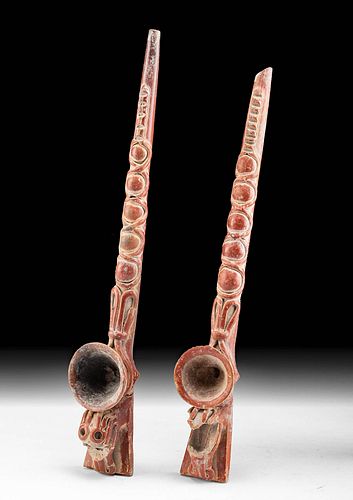Rare Pair of Tarascan Pottery Pipes w/ Rattlesnake
Lot 114
About Seller
Artemis Fine Arts
686 S Taylor Ave, Ste 106
Louisville, CO 80027
United States
Selling antiquities, ancient and ethnographic art online since 1993, Artemis Gallery specializes in Classical Antiquities (Egyptian, Greek, Roman, Near Eastern), Asian, Pre-Columbian, African / Tribal / Oceanographic art. Our extensive inventory includes pottery, stone, metal, wood, glass and textil...Read more
Categories
Estimate:
$1,000 - $1,500
Absentee vs Live bid
Two ways to bid:
- Leave a max absentee bid and the platform will bid on your behalf up to your maximum bid during the live auction.
- Bid live during the auction and your bids will be submitted real-time to the auctioneer.
Bid Increments
| Price | Bid Increment |
|---|---|
| $0 | $25 |
| $300 | $50 |
| $1,000 | $100 |
| $2,000 | $250 |
| $5,000 | $500 |
| $10,000 | $1,000 |
| $20,000 | $2,500 |
| $50,000 | $5,000 |
| $100,000 | $10,000 |
| $200,000 | $20,000 |
About Auction
By Artemis Fine Arts
Mar 4, 2021
Set Reminder
2021-03-04 10:00:00
2021-03-04 10:00:00
America/New_York
Bidsquare
Bidsquare : Ancient | Ethnographic Art Through The Ages
https://www.bidsquare.com/auctions/artemis-gallery/ancient-ethnographic-art-through-the-ages-6467
Ancient art from Egypt, Greece, Italy and the Near East, as well as Asian, Fossils, Pre-Columbian, Native American, African / Tribal / Oceanic, Fine art, and much more! All categories, all price ranges... all legally acquired and guaranteed to be as described or your money back. Artemis Fine Arts info@artemisgallery.com
Ancient art from Egypt, Greece, Italy and the Near East, as well as Asian, Fossils, Pre-Columbian, Native American, African / Tribal / Oceanic, Fine art, and much more! All categories, all price ranges... all legally acquired and guaranteed to be as described or your money back. Artemis Fine Arts info@artemisgallery.com
- Lot Description
Pre-Columbian, Mexico, Tarascan culture, ca. 1450 to 1520 CE. A superb pair of hand-built terracotta pipes, each painted with lustrous russet-hued slip and featuring a lively rendering of a serpent's head, likely a rattlesnake as both hollow heads previously held petite rattles. Each snake head rests on a trapezoidal plinth situated in front of a bowl-shaped chamber with a flared rim, a receptacle for whatever substance was smoked, perhaps peyote. The long stem of each pipe is adorned with delicate, sinuous clay appliques that twist around one another creating a motif of five circles along the top of the vessel and ending in a straight ridged rattlesnake tail that points towards the narrow blow hole. Size: 10.25" L x 1.625" W (26 cm x 4.1 cm)
Smoking pipes played an important role in Mesoamerican society. In addition to tobacco, and often prior to it, we know from ethnohistorical accounts that people smoked a variety of other plants, including dogwood, juniper, sumac, and bearberry. These pipes were not just made for the simple act of smoking; scholars have posited that they also had a ritualistic purpose.
Provenance: private Fayetteville, Arkansas, USA collection; ex-Dr. David Harner collection, Springdale, Arkansas, USA, acquired between the 1950s and 1960s
All items legal to buy/sell under U.S. Statute covering cultural patrimony Code 2600, CHAPTER 14, and are guaranteed to be as described or your money back.
A Certificate of Authenticity will accompany all winning bids.
We ship worldwide and handle all shipping in-house for your convenience.
#161404Both have been repaired from at least three pieces. Tip of blow hole and all of snake head besides tongue missing on smaller pipe. Larger piece has top of head missing. Both have expected surface wear with abrasions and nicks/chips in some areas. Excellent remaining pigments.Condition
- Shipping Info
-
All shipping is handled in-house for your convenience. Your invoice from Artemis Gallery will include shipping calculation instructions. If in doubt, please inquire BEFORE bidding for estimated shipping costs for individual items.
-
- Buyer's Premium



 EUR
EUR CAD
CAD AUD
AUD GBP
GBP MXN
MXN HKD
HKD CNY
CNY MYR
MYR SEK
SEK SGD
SGD CHF
CHF THB
THB













